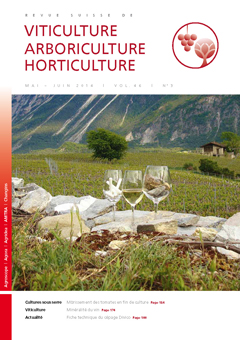
Issue 3 - May - June 2014
Abstract in open access
At the end of tomato crop, several kg/m2 of tomatoes are still to be harvested. Accelerating last tomatoes maturation in greenhouses at the end of the culture enables energy saving and avoids having to throw away tomatoes that are not quite ready for consumption. It is currently possible to accelerate the ripening of tomatoes by applying ethephon. An alternative is the injection of ethylene, a naturally produced hormone, directly in the greenhouse. In collaboration with the company Carbagas, Agroscope tested the effect of an ethylene injection in the greenhouse on ripening tomatoes. In average over the two years, the injection of ethylene enabled to harvest 1.5 truss/m2 or 0.75 kg/m2 more compared to the control compartment (1.5 % of the total yield). The addition of ethylene only slightly influenced the analytical quality of tomatoes at harvest (acidity, firmness and total soluble substances). Such an application seems to be economically profitable, but the agreement for ethylene injection in greenhouses must still be obtained.
Keywords: ethylene injection, ripening acceleration, greenhouse
E-Mail: celine.gille@agroscope.admin.ch
Adress: Agroscope, 1964 Conthey
Abstract in open access
The objective of the present study was to evaluate the use of hand-held near infrared spectroscopy to monitor the quality of tomatoes grown in greenhouse. The soluble solids content (TMS), total acidity (TA) and color settings were followed from fruit set until harvest at full maturity. This monitoring was conducted during the Spring and Summer. The spectral data and quality have been used to construct chemometric models in order to (1) monitor the fruit according to their stage of development and (2) predict fruit quality. The discriminant models have traced the chronological evolution of fruit and mark the entry in the maturation stage. Quantitative models (PLS) were used to predict the TMS, TA and fruit color considering the season and the fruit maturity stage.
Keywords: NIR spectroscopy, quality, tomato, FDA, PLS
E-Mail: cedric.camps@agrocope.admin.ch
Adress: Agroscope, 1964 Conthey
Abstract in open access
Today the concept of minerality in wines is omnipresent. It appears in marketing discourses, in oenological critics and commercial communication. However, there is no common agreement on a general definition. This paper aims to study the different expectations that Swiss and French consumers have about minerality. The multidimensionality of the term is reflected through stereotypes like the odor of flint, the impression of “sucking a stone”, or referring to acidity or to the Terroir. Thus, the term minerality appears as a unstable concept and providing a precise definition remains consequently difficult for many consumers.
Keywords: minerality, wine, expectations, flint, stone, consumers
E-Mail: pascale.deneulin@changins.ch
Adress:
Abstract in open access
High must sugar concentrations lead to a hyperosmotic stress response in Saccharomyces cerevisiae increasing the formation of acetic acid and acetaldehyde, as well as the risk of fermentation failures. This work compared the traditional batch fermentation of a very high sugar containing grape juice (340 g/l) with a fed-batch fermentation where the same juice was added at such rates as to keep sugar concentrations constant at 50 g/l during the fermentation. In both treatments, the final ethanol concentrations were similar, but higher ethanol formation rates were obtained in the fed-batch fermentations that were associated with increased yeast viability. Significantly less acetic acid and acetaldehyde remained after fed-batch fermentations. The implementation of fedbatch fermentations at low and constant substrate concentrations may be a suitable technique for increasing fermentation success and efficiency and decreasing byproduct formation in alcoholic fermentations by S. cerevisiae. Current studies at Changins will further investigate the application of this technique and its automation.
Keywords: yeast, Saccharomyces cerevisiae, alcoholic fermentation, wine, hyperosmotic stress, fed-batch
E-Mail: ramon.mira@changins.ch
Adress:

 Download of full issue
Download of full issue
 Download article
Download article